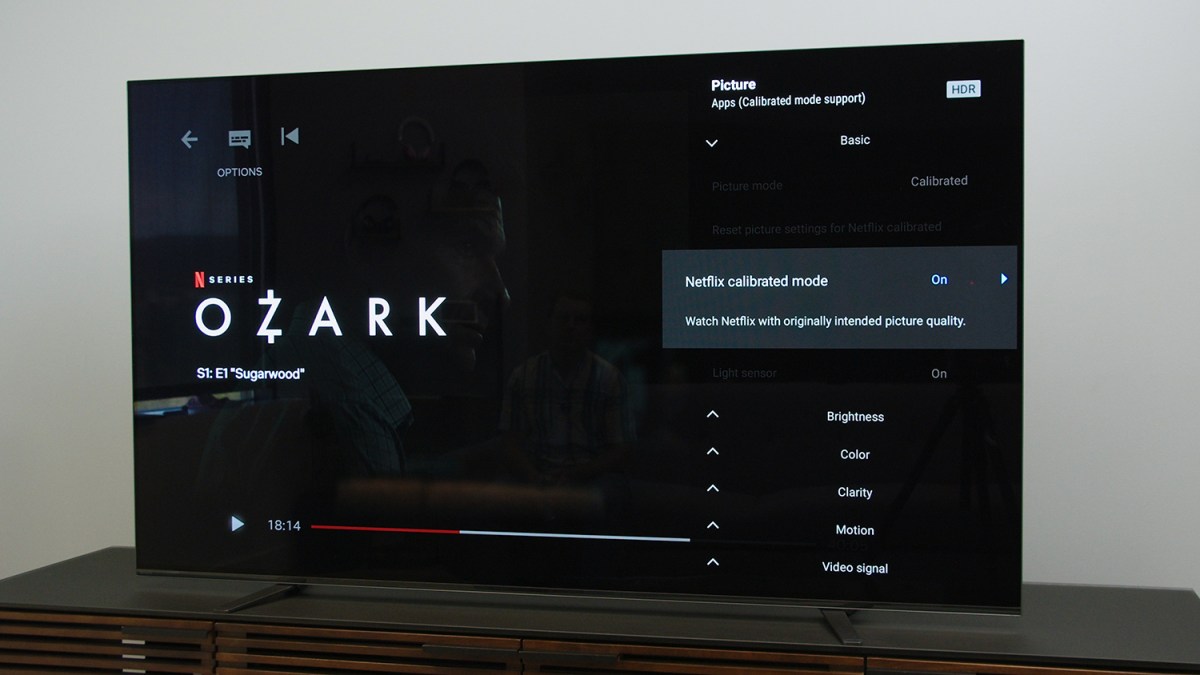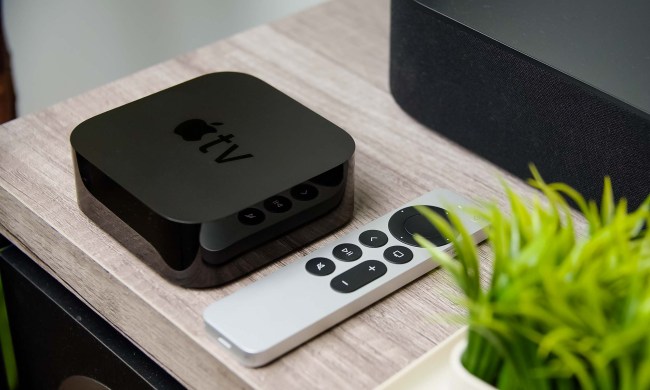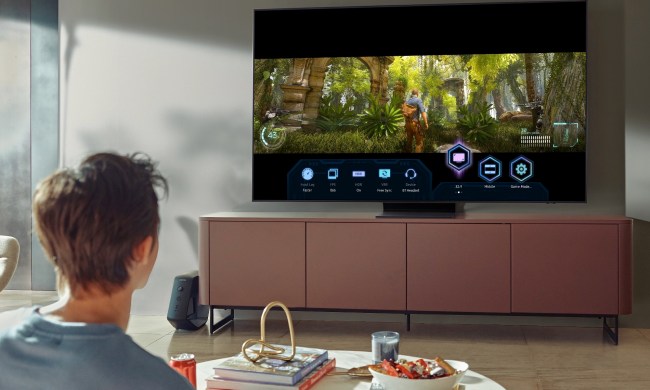- Gorgeous design
- Exemplary picture quality
- Snappy UI
- Solid sound quality
- Excellent HDR performance
- No HDMI 2.1
- Expensive
I made a bold move last year and called Sony’s A9G the best TV of 2019. Not everyone agreed that was the right call, but I stand by it. With the A9G, Sony continued to do what it has done best for decades by making its picture processing the star. LG makes the TV’s OLED panel, but Sony makes it even more astounding.
Now I have the Sony A8H OLED TV sitting in front of me, and I’m pondering its place in this year’s lineup of very exciting televisions. It’s not a replacement for the A9G, which means it’s not Sony’s new flagship, but it sure looks the part — all but in price, that is.
The A8H gets Sony’s best picture processor, a gorgeous design accented by adjustable feet, and just about every feature found on the A9G, all for less money — about $400 less for a 55-inch model at $1,900 and $500 less for a 65-inch set at $2,800. However, if this deal isn’t convincing enough for you, check out the best Black Friday TV deals for more affordable options.

There is what many might consider a glaring omission, however: HDMI 2.1 support. The A8H offers eARC via one of its HDMI ports, and that’s it. You won’t find variable refresh rate (VRR) or auto low-latency mode (ALLM), just two of many other valuable features that come with the latest HDMI standard. Still, Sony tells me it doesn’t think this will be a problem for this TV’s target audience.
Is the Sony A8H in the running for best TV of the year? Let’s find out.
Out of the box

The 65-inch Sony A8H I received for review contained two surprises: A redesigned remote control and a new two-foot stand system.
The remote didn’t exactly get overhauled, but it’s a bit more svelte than the Sony remote we’ve seen for the last five years or so. At the top of the remote is a recessed area containing a microphone, used not only for voice commands and addressing the Google Assistant but also for calibrating the TVs built-in sound system.
Sony redesigned the stand, making setup significantly easier and more versatile. There are now two heights available, one that slings the TV low, and one that allows enough clearance for a soundbar to be placed between the feet without impeding your view of the television.
No screws are necessary for securing the legs to the TV. They just pop right into slots along the bottom of the TV’s frame, and they hold solid. A little bit of work is necessary, however, to convert the legs to the taller height for what I’ll call “soundbar mode.”
Be sure to keep the setup guide handy, as it provides valuable instructions on how to disassemble, then reassemble, the feet for taller configuration.
Setup and settings

The A8H has the latest version of Android TV built-in, and it drives most of the on-screen setup process. There are some advantages to those with Android phones (quicker Wi-Fi setup and phone-based controls), but I would skip those options and follow the on-screen prompts. Do expect to wade through a bunch of terms and conditions and permissions requests. I also urge you to take enough time to review what you are allowing, as there are several levels of data collection requested, which has implications on privacy.
Once through the legal red tape, the wizard will ask to calibrate the TV’s audio. This is performed by sitting in the “sweet spot” of your viewing area and aiming the remote at the TV, face-up, while the TV plays a series of sounds.

I found this calibration to be useful in balancing the sound out with the correct amount of bass from the built-in “subwoofers,” while also making the TV sound more spacious by taking advantage of reflected sound from sidewalls. Surround sound it is not, but the calibration did make an improvement.
For SDR picture settings, I waffled between the Cinema and Custom presets for a while before settling on Custom. Turning Motionflow off was the only adjustment I ended up making to this preset before deciding that it was otherwise just about perfect. Yeah, it’s that good.

When the TV kicks into HDR mode, it maintains all of the crucial settings from the Custom preset. When it kicks into Dolby Vision mode, you’ll have the option to choose between Dolby Vision Bright and Dolby Vision Dark. I chose the former because, even in a dark room, I preferred the additional brightness (luminance).
Here’s the rub, though. Picture settings can not be made global, so if you want your cable box to get the same picture settings as your Blu-ray player, for instance, you’ll need to adjust each HDMI input individually. Likewise for onboard streaming apps like Netflix and Hulu, though once you choose settings while using any of those apps, it will apply to all apps.
Features and design

The A8H might be the most beautifully designed TV Sony has ever made. Sure, they help make the TV impossibly thin, but the materials Sony used also give it a truly premium appearance and feel. The legs are hefty metal with a matte black finish, the screen’s bezel is incredibly thin, and Sony’s logo, once front and center, has been moved to the left side while its sheen has been replaced by a much more stealthy finish. On or off, the A8H is stunning.
The user experience benefits greatly from Sony’s use of the same system on a chip (SOC) found in the A9G, which makes Android TV not just tolerable, but fairly enjoyable. Gone is the frustrating lag that typically has you waiting for the TV to catch up while you scroll. Apps load quickly too, reducing the time it takes to get to that latest episode of Ozark.
On or off, the A8H is stunning
HBO Max is also readily available, which is more than can be said for Roku or Amazon Fire TV at the moment.

The A8H’s most important feature, however, is Sony’s X1 Ultimate processor. Picture processing is everything, and it also happens to be Sony’s strongest suit in television.
Other TV manufacturers have started giving lip service to honoring “the creator’s intent,” but that’s a drum Sony has been beating for years. When Sony speaks in clever quips like “from scene to screen,” and “from the lens to the living room,” it’s shamelessly flexing.
Sony makes cameras used by Hollywood. It makes the BVM-X300 reference OLED monitor used to make and master Hollywood films, and it fashions its TVs to match that reference monitor as closely as possible. So when people at Sony tells me they are making the most cinematic TV they possibly can, I believe them.
Interestingly, Sony uses that same philosophy to explain the A8H’s lack of HDMI 2.1 support. As Sony representatives told me during a briefing call, the A8H is aimed at the videophile and cinephile — folks Sony doubts would need or want to take advantage of 4K at 120Hz, VRR and ALLM for gaming, or the ever-elusive and totally-not-in-existence 12-bit color.
Instead, Sony put its time, money, and hardware resources into making the most accurate TV possible. I feel Sony achieved its goal.
Performance

I have a feeling Sony will release a new flagship OLED TV later this year — that’s where its product release cycle has been moving over the past four years. When it does, it’s going to have to do something magical in order to justify its existence sitting next to the A8H. This TV is already so good.
Whatever it is you are looking for out of picture quality, the A8H can do it. It’s got a new black frame insertion feature that smooths out motion without overly darkening the screen. It has a pixel-level contrast booster to ensure peak brightness is applied to the right areas of the screen for maximum HDR impact.
Whatever it is you are looking for out of picture quality, the A8H can do it
The A8H also has a feature that adjusts the TV’s tone curve so that highlight detail and shadow detail are preserved no matter how bright or dark the room environment may be. Out of box color is superb, with very little tweaking left for a professional calibrator to perform. And I have yet to see a TV better eliminate annoying color banding from low-bit rate streaming content.
All of those features are a function of Sony’s X1 Ultimate processor, and the end result is a picture so luscious you’ll want to drink it like a fine craft cocktail. I’ll skip all the adjectives and boil down this TV’s picture performance to one word: Superb.

As for sound quality, it’s solid for any TV, let alone one so thin. Since the screen itself is what produces sound, you get convincing directional queues. Voices seem to come from the mouths of actors and explosions appear to come from the visual source. A TV this good deserves a bigger system, but the onboard sound is totally respectable.
How’s the input lag? It doesn’t matter. If you’re looking for a gaming TV, consider the Sony X900H, which does support HDMI 2.1 and includes an ATSC 3.0 tuner. Or consider an LG CX OLED or Samsung QLED TV for your gaming needs if you’re seeking a premium TV.
Still, if you’re dying to know, the A8H will likely exhibit the same input lag as the A8G, which was not great — about 31ms for 4K at 60Hz and 21ms for 4K at 120Hz.
One final thought regarding picture quality is the concern over burn-in and what Sony is doing to combat it. Sony does have auto-brightness limiting (ABL) on the A8H, but so far I’ve not been able to thoroughly test it to determine how much it dims the image, and over what range of time it dims. I’ll update this review with that information soon. Subjectively, though, I haven’t seen any dimming taking place with any of the content I have watched so far.
Other efforts such as pixel shifting are not apparent, and I’ve reached out to Sony to clarify what measures it is taking to avoid burn-in. With that said, I will repeat what I’ve said in every OLED TV review for the past two years. Burn-in is unlikely to affect most viewers.
When burn-in does occur, it happens when one watches a particular channel with a static image (like a news ticker on CNN or Fox News) for several hours a day, every day. If you are the sort that tunes the TV to such a station and leaves it on for 6 to 8 hours a day, do not buy this TV. Look for an LED/LCD TV. The Samsung Q90T would be an excellent alternative, approaching OLED picture quality, for just a little less money.
Our Take
The A8H OLED is an undeniably premium TV with a premium price to match, though it comes in a bit shy of Sony’s typical flagship pricing. The investment required is rewarded with one of the most cinematic TVs we’ve reviewed to date. For the videophile and cinephile, the A8H is an outstanding choice. Gamers, however, should look elsewhere.
Is there a better alternative?
For gamers, we’d suggest looking at the LG CX OLED or last year’s LG C9 OLED TV. For those looking for a bit more style, LG’s GX Gallery series is also quite attractive and gamer-friendly. For purists who want the best picture quality available in an OLED, the A8H is impossible to beat.
Check out our best televisions of 2020 for more options.
How long will it last?
The TV itself should last for many years, however, the lack of HDMI 2.1 means that next-gen console gamers and PC gamers will find it lacks appeal.
Warranty
Sony offers a one-year warranty for its A8H series TVs, provided you purchase the TV from an authorized dealer. The warranty is specific about keeping product packaging, so take a look at the fine print.
Should you buy it?
Yes. For the best OLED TV picture quality you can find with a truly cinematic experience, the A8H is a top choice.





